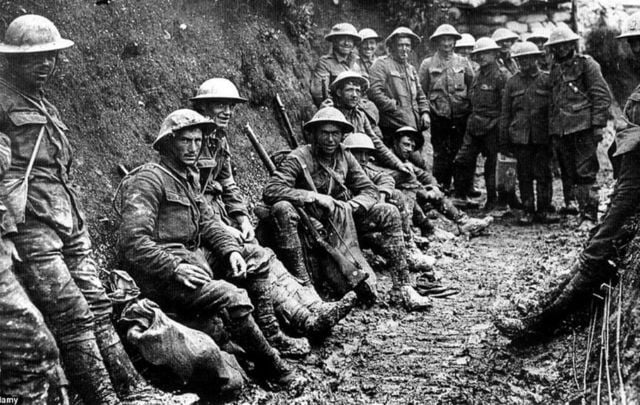Top Stories
Ireland’s Anti-Conscription Movement Sparks Political Shift in 1918

As 1918 began, Ireland faced a pivotal moment in its history. The introduction of the Military Service Act by British Prime Minister Lloyd George aimed to impose conscription on Irish men to bolster the British army during World War I. This move ignited widespread opposition across Ireland, uniting various groups against what many viewed as an affront to national dignity.
At the time, approximately 300,000 Irish men had voluntarily joined the British military to support the war effort against German expansion. However, the prospect of conscription was a line that the Irish people were unwilling to accept. The situation intensified when the German military began to falter, turning the tide of the war in favor of the Allies. By the end of 1918, while the war in Europe was concluding, the struggle for Irish independence was just beginning.
Formation of the Irish Anti-Conscription Committee
In April 1918, following the passage of the Military Service Act, a coalition emerged in opposition. The moderate Irish Parliamentary Party (IPP) joined forces with the revolutionary party Sinn Féin, labor activists, and trade unionists to create the Irish Anti-Conscription Committee. This alliance represented a rare convergence of interests among nationalists, labor groups, and the Catholic Church, which played a crucial role in mobilizing public sentiment against conscription.
On April 21, just days after the Act was introduced, congregants at churches across Ireland were urged to pledge resistance. In a significant show of solidarity, the Irish labor movement organized a one-day strike, effectively paralyzing key industries, including munitions factories. The joint platform of the IPP and Sinn Féin at rallies marked a watershed moment in Irish politics, demonstrating the growing discontent with British rule.
The IPP, once the dominant political force in Ireland, found itself increasingly out of touch with public sentiment. Under the leadership of John Redmond, the party had supported the British war effort on the premise of gaining home rule. However, Redmond’s disconnect from the Irish populace became glaringly evident, particularly in the wake of the Easter Rising in 1916, which had heightened revolutionary fervor.
The Unraveling of the IPP and Rise of Sinn Féin
As the IPP’s political capital dwindled, Sinn Féin began to gain traction. In the aftermath of the conscription crisis, the IPP withdrew from its previous stance, tacitly conceding that Sinn Féin’s policy of abstention from the British parliament was increasingly justified. The British government’s response to the unrest further alienated the IPP, particularly after the arrest of 73 prominent Sinn Féin leaders, including Arthur Griffith and Éamon de Valera, in May 1917. These arrests, lacking substantial evidence, only solidified Sinn Féin’s position as the vanguard of the anti-conscription movement.
The Catholic Church’s involvement lent further legitimacy to Sinn Féin’s cause, with younger clergy increasingly participating in the Republican movement. The arrival of American troops in France that summer shifted the balance of the war, leading to Germany’s eventual defeat in November 1918.
In the wake of the war, a transformed electorate emerged in the United Kingdom, including Ireland. For the first time in eight years, citizens were able to vote in an election. The new voting laws allowed women over the age of 30 with property and men over the age of 21 to participate, expanding the electorate from 700,000 to 1.9 million across the country.
Sinn Féin capitalized on the political upheaval caused by the conscription crisis, significantly increasing its membership from approximately 66,000 at the beginning of the year to around 112,000 by year-end. The party developed an effective election strategy, producing pamphlets and organizing clubs to engage new voters.
In the December 1918 general election, Sinn Féin achieved a resounding victory outside of Ulster, winning nearly every seat except for three. Remarkably, many of its candidates were either imprisoned, in hiding, or abroad at the time of the election. In stark contrast, the IPP managed to secure only six seats, highlighting its rapid decline.
In the aftermath of Sinn Féin’s electoral success, Father Michael O’Flanagan remarked, “The people have voted Sinn Féin… what we have to do now is explain what Sinn Féin is.” This statement foreshadowed the turbulent events that would soon unfold, leading to the Irish War of Independence.
The events of 1918 not only marked a turning point for Ireland but also set the stage for a broader struggle for independence that would shape the nation’s future. The opposition to conscription galvanized a diverse coalition, reshaping the political landscape and laying the groundwork for Sinn Féin’s rise to prominence.
-

 Top Stories2 months ago
Top Stories2 months agoTributes Surge for 9-Year-Old Leon Briody After Cancer Battle
-

 Entertainment4 months ago
Entertainment4 months agoAimee Osbourne Joins Family for Emotional Tribute to Ozzy
-

 Politics4 months ago
Politics4 months agoDanny Healy-Rae Considers Complaint After Altercation with Garda
-

 Top Stories3 months ago
Top Stories3 months agoIreland Enjoys Summer Heat as Hurricane Erin Approaches Atlantic
-

 World4 months ago
World4 months agoHawaii Commemorates 80 Years Since Hiroshima Bombing with Ceremony
-

 Top Stories2 months ago
Top Stories2 months agoNewcastle West Woman Patricia Foley Found Safe After Urgent Search
-

 Top Stories4 months ago
Top Stories4 months agoFianna Fáil TDs Urgently Consider Maire Geoghegan-Quinn for Presidency
-

 World4 months ago
World4 months agoGaza Aid Distribution Tragedy: 20 Killed Amid Ongoing Violence
-

 World4 months ago
World4 months agoCouple Convicted of Murdering Two-Year-Old Grandson in Wales
-

 World4 months ago
World4 months agoAristocrat Constance Marten and Partner Convicted of Infant Murder
-

 Top Stories3 months ago
Top Stories3 months agoClimbing Errigal: A Must-Do Summer Adventure in Donegal
-

 Top Stories3 months ago
Top Stories3 months agoHike Donegal’s Errigal Mountain NOW for Unforgettable Summer Views









